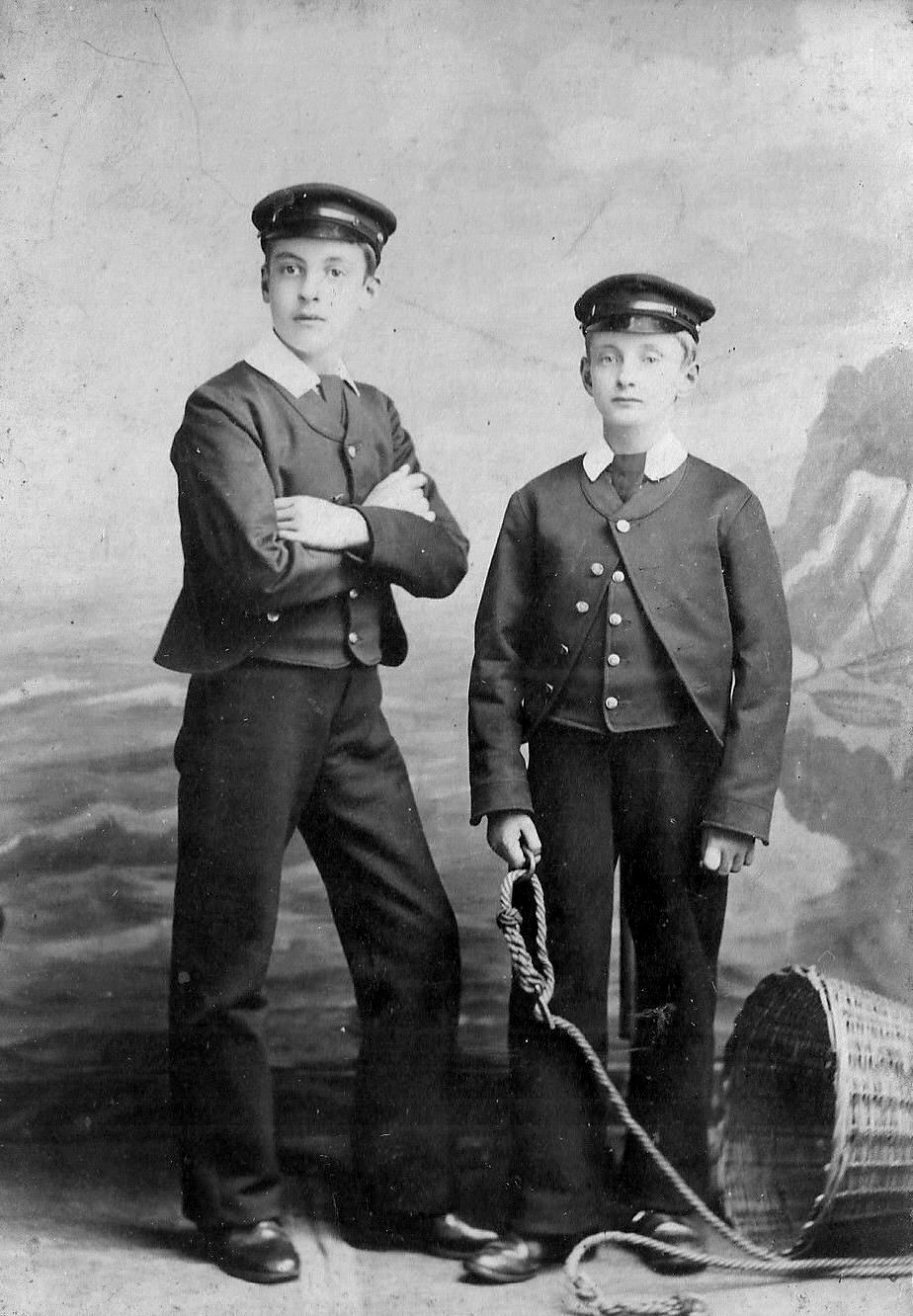
Individual English Schools--Royal Naval School

Figure 1.--This cabinet card portrait shows two boys probably brothers. They attended the Royal Navy School
at New Cross/Lewishan in south-east London. The portrait was taken in he 1880s. The boys would have been the sons of a Royal Navy Officer who had been killed. It was a charity institution to serve to purposes. first to make sure the boys received a good eduction. Second to provide a source of officer canditates for the Royal Navy. ^he boys wear cut-away jackets with Eton collars and cadet caps. Notice how the neckwear is tied. Photographer: H. Brown in Lewishan.
|
|
The Royal Naval School (RNS) was established in Camberwell, London (1833). It was formally constituted by Parliament in the Royal Naval College Act (1840). It was a charitable institution, established as a boarding school for the sons of officers in the Royal Navy and Royal Marines. It can thus be described variously as a charitable public, military, and boarding school. The sons of naval officers might not be reduced to abject poverty with the lass of a father, but the family would have in many cases been unable to aford secondary education leading to an officers's appointment in the Royal Navy. It was also one of a range of steps in professionalizing the training of Royal Navy officers. Previously officers and ratings (enlited nen) were largely trained aboard Royal Navy ships. It was established along the lines of a public (elite secondary boarding) school with a miliitary twist. This can be seen with the uniform with included an Eton jacket and collar. The Navy constructed a monumental purpose-built school building designed by the respected architect, John Shaw Jr. The new building was constructed at New Cross/Lewishan in south-east London (close to Deptford and Greenwich), both areas with strong naval connections. The new building was opened (about 1844). The school outgrew the building and relocated to Mottingham (1889). The building continued to be used at a school. It was purchased by the Worshipful Company of Goldsmiths for £25,000. It was re-opened by the Prince of Wales (July 1891) as the Goldsmiths' Technical and Recreative Institute (july 1891). It was more commonly known as the Goldsmiths' Institute. It became the main building of Goldsmiths College (1904). It was bombed by the Luftwaffe during World War II. The Royal Naval School remained at Mottingham until it closed (1910). That building is today occupied by Eltham College. The Royal Naval School is notable for the number of its graduates who achieved prominence in military and diplomatic service. A memorial to those lost invarious conflicts is located in Goldsmith's College. Other schools with the same name were opened in Malta and Ceylon (Sri Lanka). The Navy also formed The Royal Female School for the Daughters of Vocal and Marine Officers (1840). The name was later changed to The Royal Naval School or RNS.
HBC-SU

Related Chronolgy Pages in the Boys' Historical Web Site
[The 1880s]
[The 1930s]
[The 1940s]
[The 1950s]
[The 1960s]
[The 1970s]
[The 1980s]
Related Style Pages in the Boys' Historical Web Site
[Long pants suits]
[Short pants suits]
[Socks]
[Eton suits]
[Jacket and trousers]
[Blazer]
[School sandals]
Navigate the Boys' Historical Clothing School Uniform Pages
[Return to the Main English alphabetical M-Z individual school page]
[Return to the Main English alphabetical individual school page]
[Australia]
[England]
[France]
[Germany]
[Italy]
[Japan]
[New Zealand]
[Scotland]
[United States]
Navigate the Boys' Historical Clothing Web Page
[About Us]
[Chaarity schools ]
[Naval schools]
[Public schools]
[Activities]
[Chronology]
[Clothing styles]
[Countries]
[Debate]
[Economics]
[Garment]
[Gender]
[Hair]
[History]
[Home trends]
[Literary characters]
[School types]
[Significance]
[Transport and travel
[Uniform regulations]
[Year level]
[Other topics]
[Images]
[Links]
[Registration]
[Tools]
[Return to the Historic Boys' School Home]
Created: 6:16 PM 8/18/2017
Last updated: 6:16 PM 8/18/2017




